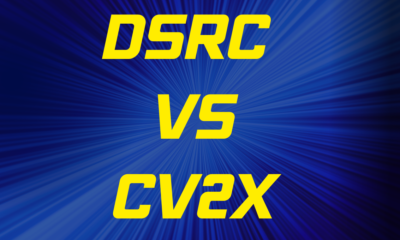Tech
Saying Goodbye to Road Accidents
Published
4 years agoon
By
Marks StrandV2x Technology: Saying Goodbye to Road Accidents
Imagine a vehicle that’s aware of every vehicle and pedestrian within a one-kilometre radius. Aware of their exact location, speed, and direction. Imagine if this awareness went beyond the vehicle’s line of sight and accounted for bends in the road, intersections, obstruction by trucks, and bad weather.
If such technology was possible, accidents would reduce greatly. They might even become a thing of the past.
You don’t have to imagine such a world very hard. Advances in technology are ushering in the age of accident-free road travel.
Smart Technology
Nowadays, it seems like everything cool has the word smart in it. We have smartphones, smart homes and appliances, smartwatches, smart television… The list goes on and on.
So, if you guessed that smart technology has something to do with a future free of road accidents, you were right.
Connectivity and communication are key features of smart technology. Connectivity in a smart home makes it possible to control your smart fridge from anywhere in the world using your smartphone.
For our roads to be safer, vehicles will need to have advanced communication and connectivity with everything around them. Great progress has been made with autonomous vehicles, but is it enough?
We Need More than Self Driving Cars
Self-driving cars have been made possible by equipping vehicles with the ability to interact with the environment. For instance, they have cameras to see what surrounds them. In addition, they use technology such as radar to learn more about what they see.
The abilities of self-driving vehicles to interact with their environment are quite advanced. However, there have been limitations. For example, no camera can see a pedestrian or vehicle that is outside the line of sight.
This means that while autonomous vehicles are awesome, on their own, they are no better than humans at preventing accidents.
Vehicle to Everything Communication
If accidents are to be a thing of the past, vehicles have to be able to communicate fully with everything around them. At the moment, autonomous vehicles interact with their environment primarily by seeing. For maximum road safety, in addition to seeing other entities like pedestrians, vehicles will have to talk to them.
V2x technology is making reliable communication among entities on roads possible.
How Vehicle to Everything Communication Would Work
For V2x technology to deliver the intended road safety results, every entity on the road has to be equipped with a communication unit. Such entities include infrastructures like intersections, traffic lights, and parking systems. Pedestrians and cyclists would also have to be connected, possibly through smartphones. Of course, for maximum effectiveness, all vehicles would have to be connected.
Once all entities on roads have been equipped to communicate, all that’s left is for them to exchange information in real-time. Moving entities, such as vehicles and cyclists, would continuously generate data about their location, direction, and speed. This data would be shared with vehicles in the vicinity.
Stationary entities like intersections would collect information about all surrounding entities. For example, through cameras and radar, data about vehicles approaching an intersection would be collected. This data would then be broadcast, enabling approaching vehicles to see outside their line of sight, for example around bends.
For intersections to generate and relay data to surrounding vehicles in real-time, they would have to be made smart.
Smart Intersections Are Key in Vehicle to Everything Communication
With many accidents happening at intersections, they have presented a major challenge to road safety. One solution would be to make the intersections smart and link them to the vehicle-to-everything communication ecosystem.
A smart intersection would not only be able to capture data about the surroundings but also transmit that data. It would be fitted with cameras and radar to allow it to see. It would also be fitted with communication devices.
Accidents at intersections often happen because an oncoming vehicle is out of the driver’s line of sight. At a busy intersection, it can also be difficult to keep track of all moving objects. Thanks to advances in big data and artificial intelligence, a smart intersection can comfortably monitor an intersection and help drivers or autonomous vehicles make safer decisions.
Challenges Facing the Adoption of Vehicle to Everything Communication
As we’ve seen so far, vehicle-to-everything communication is key to road safety. However, before the system can be fully implemented, there are substantial challenges that will have to be overcome. Below are the main challenges:
The Huge Scale of Collaboration Required
If some vehicles are connected and others are not, we won’t have made much progress in the quest for road safety. Similarly, if some intersections are smart and others aren’t, we won’t reap the full benefits. For this approach to road safety to work, all players have to be involved.
Cities have to commit to building the infrastructure required. Vehicle manufacturers have to commit to installing all vehicles with the necessary technology.
Getting all the parties involved to work towards the same goal is not easy. This remains a key problem, one we will have to find a way of working around.
Competing Communication Technologies
Currently, there are two competing communication technologies.
One uses a wireless local area network. It can be likened to wi-fi. It has a maximum range of 1km, is very reliable, and has low latency. It works perfectly even in extreme weather conditions and is not dependent on the presence of cellular network coverage.
The other technology is cellular and has two operational modes. The first mode enables vehicle-to-vehicle communication. It is designed for warnings such as speed limit violations, imminent collisions, and road hazard warnings. The second operational mode enables vehicle-to-network communication. It is designed for use cases that don’t have strict low latency requirements, such as infotainment.
It is uncertain which technology will be made the industry standard. This uncertainty might cause implementation delays because industry players will be keen to adhere to the agreed-upon standard. However, both technologies could end up being used together. This way, we’d get the best of both.
Security Vulnerability
If vehicles will be communicating with each other, then the question of whether that communication can be tampered with is unavoidable. Before vehicle-to-everything communication can be embraced, the security issue will have to be dealt with.
Of the possible solutions, using blockchain technology to implement a decentralized multiparty system is the most promising. The good news is that efforts are already underway to develop a standard to enable safe communication across different manufacturers and suppliers.
Data Storage and Processing
Having many vehicles generating and sharing information will require huge data handling and processing capabilities. In addition, smart infrastructure like intersections will generate even more data. The only way to handle and make sense of all this data will be artificial intelligence.
Artificial intelligence has been applied widely in the automotive industry. However, its use will have to be extended.
Conclusion
It is possible to live in a world with significantly fewer road accidents. To do this, we’ll have to make road infrastructure smart and make it possible for vehicles to communicate with all entities on roads. The benefits of this include not only improved safety but also perks such as efficient parking allocation and better traffic flow.
However, the path to improved road safety is paved with significant challenges. Still, it’s comforting to know that we are making progress in developing solutions. All in all, a world where road accidents are a thing of the past seems within reach.
You may like
Business Solutions
Geneo Glam: Skin Firming Treatment for Radiant, Youthful Skin
Geneo Glam is the ultimate skin firming treatment designed to restore elasticity, enhance radiance, and leave you with a glowing, youthful complexion.
Published
3 days agoon
May 9, 2025By
Marks Strand
The Geneo Glam skin firming treatment is a luxurious, non-invasive facial that revitalizes the skin by improving firmness, elasticity, and hydration. Using advanced OxyPod technology, this treatment delivers a unique combination of exfoliation, oxygenation, and infusion of active ingredients to help the skin look smoother, tighter, and more radiant.
Key Benefits
- Firms and Hydrates
The treatment boosts collagen and elastin production, helping skin feel firmer and more supple. - Improves Elasticity
Increases the skin’s resilience and reduces the appearance of fine lines and wrinkles. - Prevents Collagen Breakdown
Helps preserve the skin’s youthful structure by protecting existing collagen and supporting healthy cell function.
Powerful Natural Ingredients
- 24K Gold Particles
Stimulate collagen production, protect skin fibers, and encourage cell renewal for a firmer, lifted appearance. - Silk Amino Acids
Strengthen the skin barrier, lock in moisture, and support collagen synthesis to reduce visible signs of aging. - Carnosine Peptides
Help protect the skin from sugar-related damage (glycation), delay cellular aging, and extend the life of skin cells. - Copper
An antioxidant and anti-inflammatory that supports collagen development, smooths fine lines, and helps with skin regeneration.
How the Treatment Works
- Exfoliation and Oxygenation
The Geneo Glam OxyPod is activated with a Primer Gel, gently exfoliating the skin and triggering a natural oxygenation process that increases blood flow and enhances skin vitality. - Infusion of Actives
Active ingredients such as gold particles, peptides, and amino acids are infused deep into the skin to firm and rejuvenate. - Hydration and Nourishment
A final serum containing hyaluronic acid, rosehip oil, and marula oil hydrates and soothes the skin, leaving it soft and glowing.
Who Should Try Geneo Glam?
This treatment is ideal for people who want to:
- Reduce fine lines and early signs of aging
- Firm and tighten sagging skin
- Restore hydration and improve skin tone
Geneo Glam offers a refreshing way to firm, lift, and hydrate your skin—leaving you with a youthful glow and smooth, resilient skin. It’s a perfect solution for anyone seeking visible results without invasive procedures or downtime.
Business Solutions
H.265 miniature UAV encoders: A comprehensive Overview
H.265 miniature UAV encoders revolutionize aerial technology with advanced video compression, ensuring high efficiency and superior performance for modern UAV systems.
Published
4 days agoon
May 8, 2025By
Adva
As the demand for high-quality, real-time video transmission from unmanned aerial vehicles (UAVs) continues to rise in both military and commercial applications, the need for efficient, compact video encoding solutions has become paramount. H.265 miniature UAV encoders represent a significant advancement in this space, providing robust video compression in a small, lightweight package ideal for drones with stringent size, weight, and power (SWaP) constraints. Leveraging the power of High Efficiency Video Coding (HEVC), also known as H.265, these encoders allow UAVs to deliver high-resolution video over constrained data links, enhancing situational awareness and operational effectiveness without overwhelming available bandwidth.
H.265 is a video compression standard that succeeds H.264/AVC and offers approximately double the data compression ratio at the same video quality level. This efficiency is particularly beneficial for UAV applications, where bandwidth and power availability are limited, especially during beyond-line-of-sight (BLOS) missions or in contested environments. With H.265 encoders, UAVs can stream 1080p or even 4K encoder video in real time while consuming significantly less data than older standards. This is critical for operations such as intelligence, surveillance, and reconnaissance (ISR), where maintaining video clarity over long distances or through relay networks is essential for accurate decision-making.
Miniature H.265 UAV encoders are engineered to operate under harsh environmental conditions while maintaining optimal performance. These devices are typically ruggedized, featuring extended temperature ranges, shock resistance, and electromagnetic shielding to ensure reliable operation in military or field environments. Despite their small size—often no larger than a deck of cards—they include advanced features such as low-latency encoding, dynamic bitrate control, encryption, and support for multiple streaming protocols including RTSP, RTP, and MPEG-TS. This allows them to integrate seamlessly into existing command-and-control infrastructure and support a variety of end-user applications, from real-time ground monitoring to autonomous navigation and object tracking.

The integration of H.265 encoders into small UAVs has significantly expanded the capability of tactical drone systems. For example, military units can deploy hand-launched drones equipped with these encoders to provide persistent ISR coverage over a battlefield, transmitting clear, actionable video intelligence back to command centers in near real time. Law enforcement agencies and border security forces also benefit from these technologies, using UAVs to monitor large or remote areas with minimal personnel. In disaster response scenarios, such encoders enable drones to deliver live aerial assessments of affected regions, helping responders prioritize actions and coordinate relief efforts efficiently.
Beyond video transmission, modern H.265 UAV encoders are increasingly integrated with onboard artificial intelligence modules that enable edge processing. This allows UAVs to perform real-time object recognition, motion detection, and scene analysis directly within the encoder, reducing the need to send raw data to centralized systems for processing. Such capabilities are crucial in time-sensitive missions where latency can affect outcomes, such as tracking moving targets or identifying threats in complex terrain.
Despite their many advantages, the deployment of H.265 miniature encoders does come with some technical considerations. The encoding process, while more efficient than previous standards, requires higher computational resources. Manufacturers must therefore strike a careful balance between processing power, thermal management, and energy consumption. Additionally, the compatibility of H.265 streams with legacy systems remains a factor, as not all ground stations or video players natively support HEVC decoding without updates or specialized software.
Manufacturers of H.265 miniature UAV encoders include companies such as IMT Vislink, Soliton Systems, Haivision, and VITEC, all of which provide solutions tailored to UAV and robotics applications. These encoders are often modular, allowing integrators to select configurations based on mission requirements, payload limitations, and transmission needs. As the ecosystem of compact, high-efficiency video systems grows, continued innovation in low-power silicon and AI integration is expected to drive the next wave of capability enhancements in this field.
In the evolving landscape of drone technology, H.265 miniature UAV encoders stand out as a critical enabler of high-performance video transmission. By combining advanced compression with minimal SWaP impact, these systems provide UAV operators with the tools to observe, analyze, and act with unprecedented precision and clarity—no matter how small the platform or how demanding the environment.
Business Solutions
IEEE 802.11p and V2X Communication: Enabling Smarter, Safer Roads
IEEE 802.11p revolutionizes V2X communication, driving smarter, safer roads through advanced vehicle connectivity. This cutting-edge technology enhances transportation systems, enabling intelligent and secure interactions for a safer future.
Published
5 days agoon
May 7, 2025By
Adva
Modern vehicles are no longer isolated machines; they are becoming intelligent, connected nodes within a larger transportation ecosystem. At the heart of this transformation is Vehicle-to-Everything (V2X) communication, which enables cars to talk to each other and to the infrastructure around them. One of the first and most influential technologies developed to support V2X is the IEEE 802.11p standard—a wireless standard specifically tailored for vehicular environments.
What is IEEE 802.11p?
IEEE 802.11p is an amendment to the IEEE 802.11 standard (commonly known as Wi-Fi), designed to enable wireless access in vehicular environments. It was approved in 2010 and forms the basis for Dedicated Short-Range Communications (DSRC).
Key Characteristics of 802.11p:
- Frequency Band: Operates in the 5.9 GHz band reserved for Intelligent Transportation Systems (ITS).
- Low Latency: Optimized for fast, real-time communication necessary for safety-critical applications.
- Range: Effective communication range of up to 1 kilometer, suitable for high-speed vehicle interaction.
- Decentralized Architecture: Enables direct communication (V2V and V2I) without the need for cellular or network infrastructure.
- Robustness: Handles high-speed mobility and rapidly changing topologies typical of vehicular environments.

Role of 802.11p in V2X Communication
V2X (Vehicle-to-Everything) is a broader term encompassing various communication paradigms, including:
- V2V (Vehicle-to-Vehicle)
- V2I (Vehicle-to-Infrastructure)
- V2P (Vehicle-to-Pedestrian)
- V2N (Vehicle-to-Network)
- V2C (Vehicle-to-Cloud)
802.11p primarily supports V2V and V2I communications, forming the backbone of DSRC-based V2X implementations. Its low latency and direct communication capabilities make it ideal for applications such as:
- Forward collision warnings
- Intersection movement assist
- Emergency electronic brake lights
- Lane change warnings
Comparison with Cellular V2X (C-V2X)
As V2X technology has evolved, C-V2X (based on LTE and 5G standards) has emerged as a strong alternative to 802.11p. Here’s how they compare:
| Feature | IEEE 802.11p (DSRC) | C-V2X (LTE/5G) |
| Latency | ~10 ms | ~5–10 ms (LTE), <5 ms (5G) |
| Coverage | Short-range, direct | Short + long-range via network |
| Deployment | Mature, field-tested | Growing, especially with 5G |
| Infrastructure | Minimal (no cellular needed) | Requires cellular networks (for V2N/V2C) |
| Interoperability | Limited with C-V2X | Newer versions support dual-mode |
Adoption and Use Cases
Global Deployment:
- United States: Initially favored DSRC based on 802.11p, though recent FCC rulings have shifted focus toward C-V2X.
- Europe: ETSI has defined ITS-G5, a protocol stack based on 802.11p.
- Japan and South Korea: Active use of DSRC for tolling and traffic safety.
Real-World Applications:
- Collision avoidance systems
- Smart intersections
- Road hazard notifications
- Platooning for commercial vehicles
- Public transport priority systems
Advantages of 802.11p
- Mature and Proven: Used in numerous pilot programs and early deployments.
- Fast Time to Communication: No need for handshake protocols; devices can communicate almost instantly.
- No Subscription Costs: Operates independently of cellular networks.
Limitations and Challenges
- Scalability: In high-density traffic, packet collisions may reduce reliability.
- Spectrum Allocation: Regulatory changes in some countries have limited the bandwidth available to DSRC.
- Limited Ecosystem Growth: Many automakers and countries are shifting investment to C-V2X and 5G-based platforms.
Future Outlook
While 802.11p has laid the foundation for V2X communication, the industry is gradually pivoting toward more advanced and scalable technologies such as 5G NR-V2X. However, 802.11p remains relevant in regions where DSRC infrastructure is already deployed and continues to serve as a dependable option for immediate, low-latency vehicular communication.
Hybrid Solutions:
Some industry players are exploring dual-mode V2X devices that support both 802.11p and C-V2X, ensuring backward compatibility and smoother transitions.
IEEE 802.11p has played a pivotal role in launching the era of connected vehicles, offering reliable, low-latency communication tailored for high-speed mobility. While newer technologies like C-V2X and 5G are beginning to dominate the roadmap, 802.11p’s contributions remain foundational in the evolution of V2X systems. As the automotive industry moves forward, a mix of technologies, including legacy support for 802.11p, will ensure that safety, efficiency, and connectivity continue to advance on roads around the world.

Geneo Glam: Skin Firming Treatment for Radiant, Youthful Skin

H.265 miniature UAV encoders: A comprehensive Overview

IEEE 802.11p and V2X Communication: Enabling Smarter, Safer Roads
Trending
-
Marketing & Analytics2 years ago
A Complete Guide To HubSpot’s New B2B Marketing, Sales Hub, and Prospecting Tool
-
3D Technology2 years ago
3D Scanner Technology for Android Phones: Unleashing New Possibilities
-
Marketing & Analytics2 years ago
How SMS Services And Software For Bulk SMS Sending Can Help Your Business Grow
-
3D Technology2 years ago
Mobile 3D Scanners: Revolutionizing 3D Scanning Technology
-
3D Technology2 years ago
3D scanning technologies and scanning process
-
Business Solutions1 year ago
Understanding A2P Messaging and the Bulk SMS Business Landscape
-

 Business Solutions1 year ago
Business Solutions1 year agoThe Power of Smarts SMS and Single Platform Chat Messaging
-

 Automotive2 years ago
Automotive2 years agoDSRC vs. CV2X: A Comprehensive Comparison of V2X Communication Technologies




